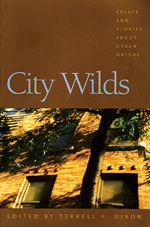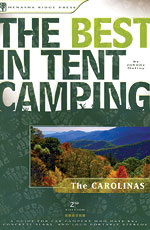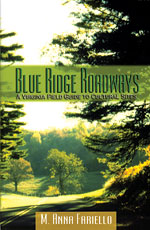Need last-minute gifts for the hiker, naturalist, tree hugger or armchair ecologist in your life? Or more to the point: Need something to help you plan your own trips in the coming year? Here are some ideas.
Brownstones and bears
 |
City Wilds: Essays and Stories about Urban Nature edited by Terrell F. Dixon (University of Georgia Press, 2002), $19.95.
Most nature writing concentrates on wildness — the pristine forests, the wilderness areas. The implication is clear: The wilder the better. But the reality is that most of us live in urban areas. Even in Asheville, so close to honest-to-goodness mountains, I spend a lot of time rambling around Beaver Lake and along our urban greenways. The City Wilds anthology understands that the geographic differences and multicultural makeup of our cities make them interesting as “wild” places in their own right.
In “Paddling off the Edge of the Big Easy,” Bob Marshall recounts his canoe trip into a bayou a mere 20-minute drive from New Orleans’ French Quarter. The essay contains an eerie prediction of the Hurricane Katrina disaster, when Marshall writes, “Some scientists even think New Orleans should immediately look for a new site for itself, planning ahead for the day when the Gulf eats the last of the wetlands and pounds on the levees of the French Quarter.”
The funniest essay in the book has to be “Big City Waters,” by Michael Aaron Rockland, which is about canoeing around Manhattan. Rockland (a professor at Rutgers University) and his firefighter neighbor circumnavigate the storied island — a trip of 31 miles — in two days, camping along the way. Rockland writes, “Here we were in Manhattan, the most intense spot on the globe, but you couldn’t know a more profound solitude.”
Behind the nylon curtain
 |
The Best in Tent Camping: The Carolinas, by Johnny Molloy (Menasha Ridge Press, second edition 2006), $14.95.
Johnny Molloy is something more than a trail-guide writer; he seems to be an institution. Whether he’s tackling North Carolina, the Great Smoky Mountains, Kentucky or Florida, Molloy has a writing schedule on a par with that of the most harried marketing exec, according to an article last year in the marketing journal Fast Company. At any given moment, he’s juggling a handful of projects that include all the elements: researching, writing, updating and promotion. It bears mentioning that Molloy, a full-time outdoors writer at the top of his profession, makes $27,000 a year and is always waiting for the next paycheck.
Books in The Best in Tent Camping series include detailed maps of all the campgrounds cited, plus such key information as fees, reservations, and rules on pets and fires. A “Getting There” box contains detailed driving directions, and a map of each campground gives the reader an idea of the place’s layout. Some maps even show actual site numbers. If car camping in a tent is your preferred mode of travel, then this series will be useful to you.
Want more Molloy? The Day and Overnight Hikes series (Menasha Ridge Press), $12.95 for most editions, are thin books that describe about 40 hikes apiece and include maps and profiles. There’s not much on the flora, fauna or human history of each place, but the books do include enough information to get you on the trail and back to your car.
Border crossing
 |
Blue Ridge Roadways: A Virginia Field Guide to Cultural Sites by M. Anna Fariello (John F. Blair, 2006) $17.95.
Sometimes you just need to get out of the state and take a road trip, and Fariello’s book is the one to do it with. A visiting professor at Western Carolina University, she directs a project on regional heritage. Her book documents cultural sites in Virginia, organized into driving tours.
Whenever I drive north into Virginia on Interstate 81, I pass a sign for Hungry Mother State Park. I always wondered about the name, and Fariello explains it in her book. Back in the 18th century, some Native Americans traveling through the area destroyed several European settlements. According to legend, a woman and her daughter escaped the attack and wandered into the forest. When rescuers found them, the mother was dead and the daughter could say only two words: “Hungry Mother.”
Virginia has more Appalachian Trail miles than any other state. This book explains many sites encountered both on and off the trail: Grayson Highlands State Park, with its wild ponies; Mount Rogers, the highest peak in Virginia; and the town of Rural Retreat, one of my layover stops along the A.T. One surprise for me was the fact that in discussing Damascus, Fariello doesn’t mention the town’s annual Appalachian Trail Days festival (or, for that matter, the A.T. at all). The trail runs right through the town, and each May, Damascus throws a celebration when the bulk of the through-hikers get there. That’s a serious omission, in my view.
On balance, though, the book is good, with clear maps for its five driving tours and a number of historic and contemporary photographs.
Whose woods these are
Trees of the Southeastern United States by Wilbur H. Duncan and Marion B. Duncan (University of Georgia Press, reprint edition 2000), $22.95.
I’m trying to learn how to identify Southern Appalachian trees. Leaf, trunk, fruit — all provide clues. So does altitude. For example, there are no Fraser firs in South Carolina nor poplars on top of Cold Mountain. It’s like a detective story, and I need all the books I can get my hands on to help me.
The Duncan book will be a serious addition to your outdoors library. The guide treats more than 300 species, including all the trees known to occur in the Southeast, from the coastal plain to the highest elevations. The photographs in the middle of the book show each species’ leaves and fruit, though there’s nothing about the bark and general shape of the tree. In flower season, I can identify most wildflowers in the area, but flowers have seasons. Trees, on the other hand, are here all year long.
[Danny Bernstein, a hike leader and outdoors writer, can be reached at danny@hikertohiker.org.]



Before you comment
The comments section is here to provide a platform for civil dialogue on the issues we face together as a local community. Xpress is committed to offering this platform for all voices, but when the tone of the discussion gets nasty or strays off topic, we believe many people choose not to participate. Xpress editors are determined to moderate comments to ensure a constructive interchange is maintained. All comments judged not to be in keeping with the spirit of civil discourse will be removed and repeat violators will be banned. See here for our terms of service. Thank you for being part of this effort to promote respectful discussion.